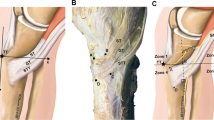Abstract
Anterior cruciate ligament (ACL) reconstruction with autogenous semitendinosus and gracilis tendons has become a common surgical procedure. Lower leg paresthesia following injury to the infrapatellar nerve during harvesting of the tendons has been well documented. Few authors have described the position of the infrapatellar nerve on a flexed knee, which is the position used during ACL reconstruction. The purpose of this study was to determine a safe area and angle where an incision could be made for harvesting of the semitendinosus and gracilis tendons, with the knee in flexion. Twenty right cadaver knees and 20 left knees were dissected. Landmarks on the knee were identified, from where the distances to the nerves (infrapatellar and saphenous) were measured with a vernier caliper. A safe area on the right knee was determined to be on the tibial tuberosity plane between 3.7 and 5.5 cm with a safe angle of incision of 51.6°. A safe area on the left knee was determined to be on the tibial tuberosity plane between 3.6 and 4.9 cm with a safe angle of incision of 52.5°. The results may assist orthopedic surgeons performing ACL reconstruction with semitendinosus and gracilis tendons to avoid cutaneous nerve damage and, therefore, patient discomfort.



Similar content being viewed by others
References
Ebraheim NA, Mekhail AO (1997) The infrapatellar branch of the saphenous nerve: an anatomic study. J Orthop Trauma 11: 195–199
Hunter LY, Louis DS, Ricciardi JR, O’Connor GA (1979) The saphenous nerve: its course and importance in medial arthrotomy. Am J Sports Med 7: 227–230
Johnson RJ, Kettlekamp DB, Clark W, Leaverton P (1974) Factors affecting late results after meniscectomy. J Bone Joint Surg Am 56: 719–729
Mochida H, Kikuchi S (1995) Injury to infrapatellar branch of saphenous nerve in arthroscopic knee surgery. Clin Orthop 320: 88–94
Pagnani MJ, Warner JJP, O’Brien SJ, Warren RF (1993) Anatomic considerations in harvesting the semitendinosus and gracilis tendons and a technique of harvest. Am J Sports Med 21: 565–571
Romanes GJ (1972) Cunningham’s textbook of anatomy, 11th edn. Oxford Medical, London, p 760
Sgaglione NA, Warren RF, Wickiewicz TL, Gold DA, Panariello RA (1990) Primary repair with semitendinosus tendon augmentation of acute anterior cruciate ligament injuries. Am J Sports Med 18: 64–73
Spier DDM, Blagg SE, Unwin AJ, Allum RL (2000) Anterior knee symptoms after four-strand hamstring tendon anterior cruciate ligament reconstruction. Knee Surg Sports Traumatol Arthrosc 8: 286–289
Acknowledgment
We would like to thank Dr. P.J. Becker from the Biostatistics Unit, Medical Research Council, South Africa.
Author information
Authors and Affiliations
Corresponding author
Rights and permissions
About this article
Cite this article
Boon, J.M., Van Wyk, M.J. & Jordaan, D. A safe area and angle for harvesting autogenous tendons for anterior cruciate ligament reconstruction. Surg Radiol Anat 26, 167–171 (2004). https://doi.org/10.1007/s00276-003-0213-z
Received:
Accepted:
Published:
Issue Date:
DOI: https://doi.org/10.1007/s00276-003-0213-z




